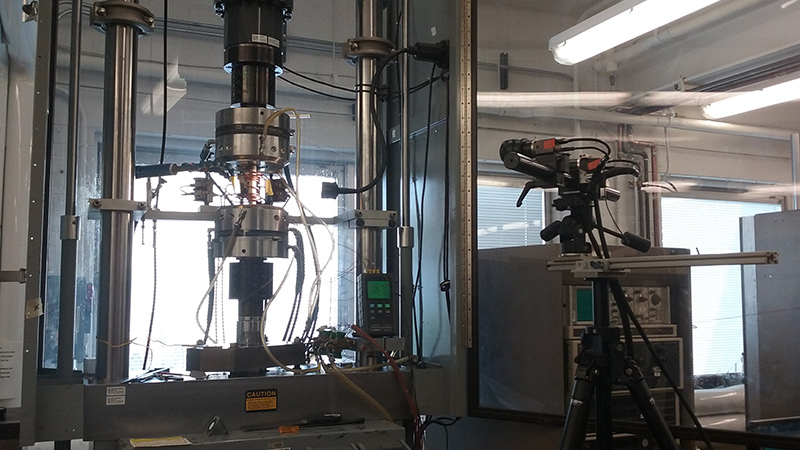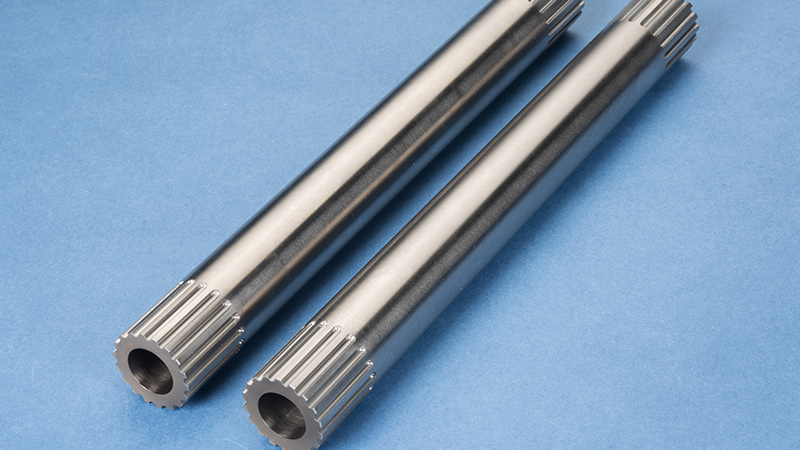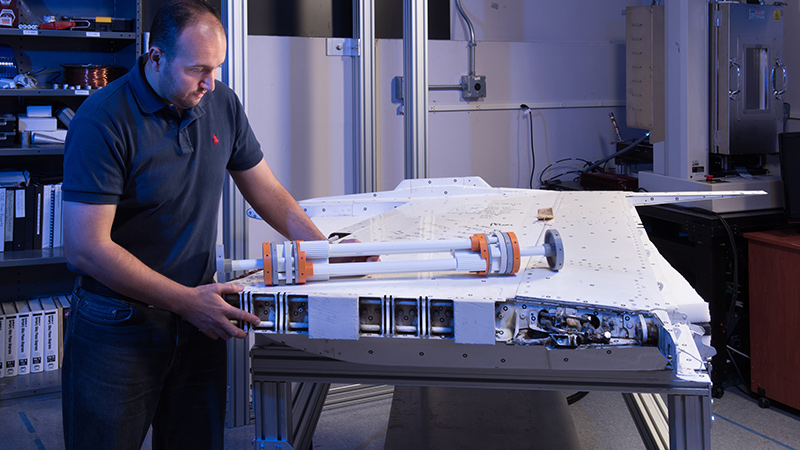Magic material
By Keith Button|November 2017
Mixing up an alloy that changes shape at specific temperatures
Othmane Benafan, a materials engineer at NASA’s Glenn Research Center in Ohio, loves talking about nickel-titanium-hafnium, a chrome-looking alloy with a bright future. He speaks of its “memory” and about “training” it, almost as if this alloy were alive. Picture a tube made of it, he says. “You heat and cool it and this tube starts twisting,” he says. “I work in this field, and it still amazes me every time I see it.”
NiTiHf is among a class of shape-memory alloys, SMAs, that materials engineers like Benafan think could give aircraft designers a slew of bold new options. Training is achieved by bending the tubes to specific angles under force, then heating and cooling them to train them to return to that angle at a specific temperature.
Benafan is co-principal investigator for the Spanwise Adaptive Wing project at Glenn. Engineers from NASA and Boeing are teaching NiTiHf a new trick: To fold aircraft wingtips or sections of wings up and down in flight. If subscale flights and lab tests show promise in the coming months, airliners and fighter jets could someday adjust their wings for maximum fuel efficiency and control without bulky hydraulics, pneumatics or electric motors.
Subscale airliner
For the airliner application, the Spanwise team needed a subscale airliner with wings that could be removed and replaced with articulating versions that fold at the wingtips. They chose an 11 percent scale version of a Boeing 737, called PTERA, short for Prototype Technology Evaluation and Research Aircraft. This unmanned aircraft was built by Area I, a small company in Kennesaw, Georgia. The engineers cut each composite wing about 30 centimeters from the tip and reattached the wingtips, connected to the root wing by a single NiTiHf tube or actuator.
Now, newer passenger planes fly with fixed, upward-bent wingtips, called winglets, which reduce drag and save fuel. But adding wingtips that could fold up or down to specific angles could maximize yaw control or lift for their planes during specific flight phases, such as takeoff, landing, climb-out, descent and cruise, says Matthew Moholt, NASA’s principal investigator on the Spanwise project. Designers could reduce or even eliminate tail rudders and their drag from new plane designs. Computer simulations show the PTERA enjoying increased yaw control or stability by folding the wings to specific angles in flight, and flight testing should prove that the simulations are correct, Moholt says.
An obvious challenge was that each tube had to bend only when desired. Under a previous NASA project, called Adaptive Trailing Edge, Boeing engineers had shown that SMA actuators could push the flaps up and down on the wings of a full-scale 737 in flight. That project was a breakthrough in that it was the first time an SMA moved a flight control surface in flight, but there was also a problem. The nickel-titanium mixture chosen for that project could start changing shape on an extremely hot day, when it wasn’t supposed to. The Spanwise team chose nickel-titanium-hafnium, believing they could formulate it to change shape only at higher-than-natural-environment temperatures. The material had a relatively long research history to draw from. The first NiTiHf material was patented in 1992; NASA started working with versions of the alloy 12 years ago. Today, NASA engineers are patenting their own new NiTiHf alloys.
The Spanwise team needed to tune the specific actuation temperatures of the nickel-titanium-hafnium alloy, says Benafan. They wanted to set the “cold” temperature — when the SMA tube would return to its original shape — at 100 degrees Celsius, well above the maximum natural environment temperatures on Earth and above the maximum performance temperatures listed for the Boeing 737. They wanted the “hot” temperature, when the alloy tube would reach its maximum angle of change, set at about 250 degrees Celsius.
Writing the alloy recipe wasn’t as simple as adding hafnium in small doses to a nickel-titanium mix. “I wish it was that easy,” Benafan says. NASA’s microstructures experts had to test the activation temperatures of nickel, titanium and hafnium mixtures measured by their atomic percentages, then add a few more atoms of one of the metals and test it again. They did that up and down the range of possible formulations for the three metals. Once they tested the range of possible formulations, they knew how to mix an alloy that would change shape at the specific temperatures they wanted.
The composition must always be exact. “If you miss, and you put in too much nickel or too much titanium, you’re just going to get a brick. You’re just going to get a tube that doesn’t do anything,” says Benafan.
Safely heating and cooling
The next question was how to safely heat and cool the tubes aboard the plane, given that they react only at unnaturally high temperatures. In the lab, heating an SMA tube is easy — just wrap a heating coil around it — and electric power supply is not a problem. But for the PTERA, the tubes have to be as lightweight and small as possible, while still exerting the required force. “You don’t want to wait 30 minutes to move up and down; you want motion that is short and fast,” Benafan says.
The answer was to place a cartridge electric heater inside each tube. For PTERA’s winglets, the engineers designed the tubes — one for each wing — at about 1.3 centimeters in diameter and 20 centimeters long, and they bend the tips of the wing up to 70 degrees. The heater controls the bending by the tube to an exact temperature associated with a specific angle between zero and 70 degrees. To speed up the cooling, which reduces the angle of bend, rather than just turning off the heater, the engineers also designed a fairing with holes through it at the front of the wing. Cool ambient air rushes in to cool the tube to a specific temperature, when the heaters are turned off. For larger versions of the SMA actuator, such as for a warplane, engineers will build a door to open and close to let air in, and they may hook up a blower to direct even more cooling air at the tube. To bend the winglets down by a maximum of 70 degrees for the test plane, an engineer has to flip a connector on the wing between flights, which reverses the gearing in the actuator. But a plus-70-to-minus-70-degree actuator would be easy to design by adding gearing to the actuator, Benafan says.
Soon it will be test time for the actuator. NASA, Boeing and Area I plan to strap the plane down and ground-test all of its flight systems in November at Area-I’s headquarters in Georgia. Then, for flight tests, an Area I pilot will remotely control the unmanned PTERA through takeoffs and landings from the dry lake bed at Edwards Air Force Base, California, where NASA Armstrong Research Center is. A computer will fly the drone once the pilot gets it airborne.
Improving a warplane
A key motivator for the Spanwise team was the near absence of research and testing on full-scale aircraft, Moholt says. “We were a little frustrated, because you see a lot of the work in this arena, and it’s all subscale and there’s no path to full-scale infusion,” he says.
So, in addition to the upcoming PTERA flights, they are preparing to ground-test their actuators on an F-18, this time folding up and down a large section of wing. The engineers chose the F-18 for a simple reason: It already has folding wings, though just for parking, not for flight. Also, F-18s were available from the “boneyard” at Edwards Air Force Base. In July, Moholt and a crew at NASA Armstrong picked an F-18 from the boneyard and detached its right wing, crated the wing up and sent it on a flatbed truck to Benafan and his team at NASA Glenn in Ohio. The NASA Glenn team cleaned the bird droppings off and laser scanned the surfaces of the wing and its folding joint. The team is building a drop-in replacement actuator for the folding wing, which will mean removing the electric motors and gearbox that normally raise the wingtips for storage in close quarters.
A challenge was building the larger actuator that would be required for a highly maneuverable warplane. Until now, the largest SMA tube that engineers had worked with was the 1.3-centimeter-diameter version that will be tested on PTERA. For the F-18, they’ll need tubes that are twice as large. This means relying on outside vendors to pour ingots that are larger than the Spanwise team can create in the lab. Hundreds of kilos of raw material are required. So far, they’ve scaled up to tubes that are twice as wide as the 1.3 cm version, starting from cylindrical ingots of the alloy about 18 cm thick and about 30 cm long. They then reduce the metal to a rod by forging and extruding — pressing the metal into dies — and drill out the center to make the tube.
NASA’s engineers are confirming and testing the properties of these tubes by applying loads and heating and cooling them through hundreds of cycles of bending on a test rig. Next, they’ll create and test the even larger tubes required for the F-18. “The material (for the larger tubes) looks good,” Benafan says, but the engineers are checking if the properties of the smaller tubes translated to the larger versions. “Did we lose any strength? Did we lose activation temperatures?”
Stepping up to the larger SMA tubes brings some complications. Larger bearing structures will be required where the actuator meets the main wing and stronger clamps will be required to hold each actuator to the inside wing and the wing tip.
“All that becomes another level of challenge, because now you have a much bigger chunk of metal that you have to heat somehow. You need to carry much more power to heat them, let alone to cool them,” Benafan says.
To get ready for the F-18, NASA Glenn engineers have built a test rig that will demonstrate that an SMA tube, or possibly a bundle of tubes, can bend 90 degrees with about 600 Newton-meters of force, and then about 2,300 Newton-meters.
Editor’s note: The image at the top of this story is an illustration of a military aircraft with wingtips that can be folded up or down during flight.
Related Topics
Aircraft Design










